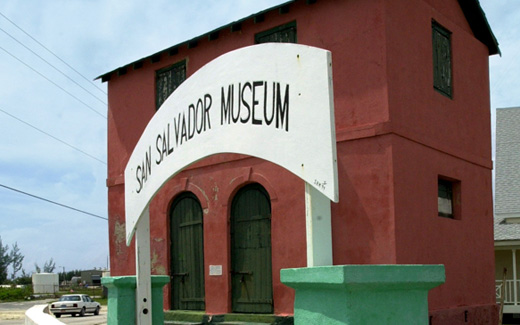
Landmarks of San Salvador
Due to its unique history, San Salvador’s landmarks consist of monuments to Christopher Columbus’ achievement and reminders of the colonial development of the islands’ inhabitants
Built in 1887 on a former plantation owned by John Dixon, the Dixon Hill Lighthouse is the last hand operated lighthouse in The Bahamas. The lighthouse stands 163 feet above sea level, has a visibility of 19 miles and is operated by 400,000 kerosene oil lit candles.
First landfall monuments and accreditation abound in San Salvador. A sphere hewn from native limestone – the Chicago Herald Monument, was erected in 1891 by the Chicago Herald, an American newspaper, in commemoration of Columbus’ landfall. A simple white cross erected in 1956 at Landfall Park, Long Bay, commemorates Columbus’ first landfall in the New World on October 12th, 1492. Also on this site is the Mexican Monument which housed the Olympic flame in 1968 on its journey from Greece to Mexico City. On August 2nd, 1991, with the erection of the UNESCO Monument, UNESCO declared San Salvador a “Monument of the Quincentennial”, thereby acknowledging it as the geographical starting point of the “new American epoch” beginning October 12th, 1492. Further, the Nao Santa Maria Monument commemorates the Japanese effort (The “Nao Santa Maria”) to recreate Columbus’ flagship, symbolizing Columbus’ original intention to reach Japan and promote harmony among nations.
Watling’s Castle, located in Sandy Point, is a late 18th century Loyalist Plantation House named for George Watling. The substantial ruins include the three-storey “Great House”, kitchen, slave quarters, barns and boundary walls while the restored Lookout Tower overlooks French Bay.
Located in the centre of San Salvador, the Great Lake Preserve served as the major waterway in days past. It has been designated a protected area to preserve its natural pristine beauty.
Mentioned by Columbus in his journal as a good site for a fortress; at low tide, one can wade out to Cut Cay which is located just across a shallow channel off North Point.
Archeological excavations at Pigeon Creek Site show that villages and a bit of the lives of the indigenous people of The Bahamas, the Lucayan/Taino Amerindians.
Previously an old U. S. Navy Base, the Bahamian Field Station has been operating for many years as a centre for academic research in Archaeology, Biology, Geology and Marine Sciences. It provides accommodations, meals and air transportation arrangements for students studying in this unique environment.
Landmarks of Rum Cay
The wreck of the 101-gun warship HMS Conqueror, built in Devon in 1855 and which served in the Crimean War, lies in 30 feet of water in a staghorn gully near the breaking reef off Rum Cay where it sank in 1861. Currently, the wreck serves as an underwater museum and is the property of The Bahamas Government. Thus, none of the contents of the ship may be removed but adventuresome divers can still find the shaft, anchor chains and hawser holes of the infamous ship.
Deep reefs and drop-offs surround this former pirates' haven. There is staghorn coral at Summer Point Reef and diving at Pinder's Point. At the Grand Canyon, 60-foot coral walls almost reach the surface.
Bahamas Out Island Packages & Promotions
Be the first to hear about the latest Bahamas Out Island resort packages and offers.
Order your Out Islands Destination Guide
Get all the information you need about the Out Islands. We'll mail it to you right away!
See a page you'd like to save or read later?
Simply click the “Save Page for later” button to save any page and read it later.
New U.S. Passport Regulations
As of January 23, 2007 all U.S. citizens are required to carry valid U.S. passports when traveling to and from The Bahamas.



